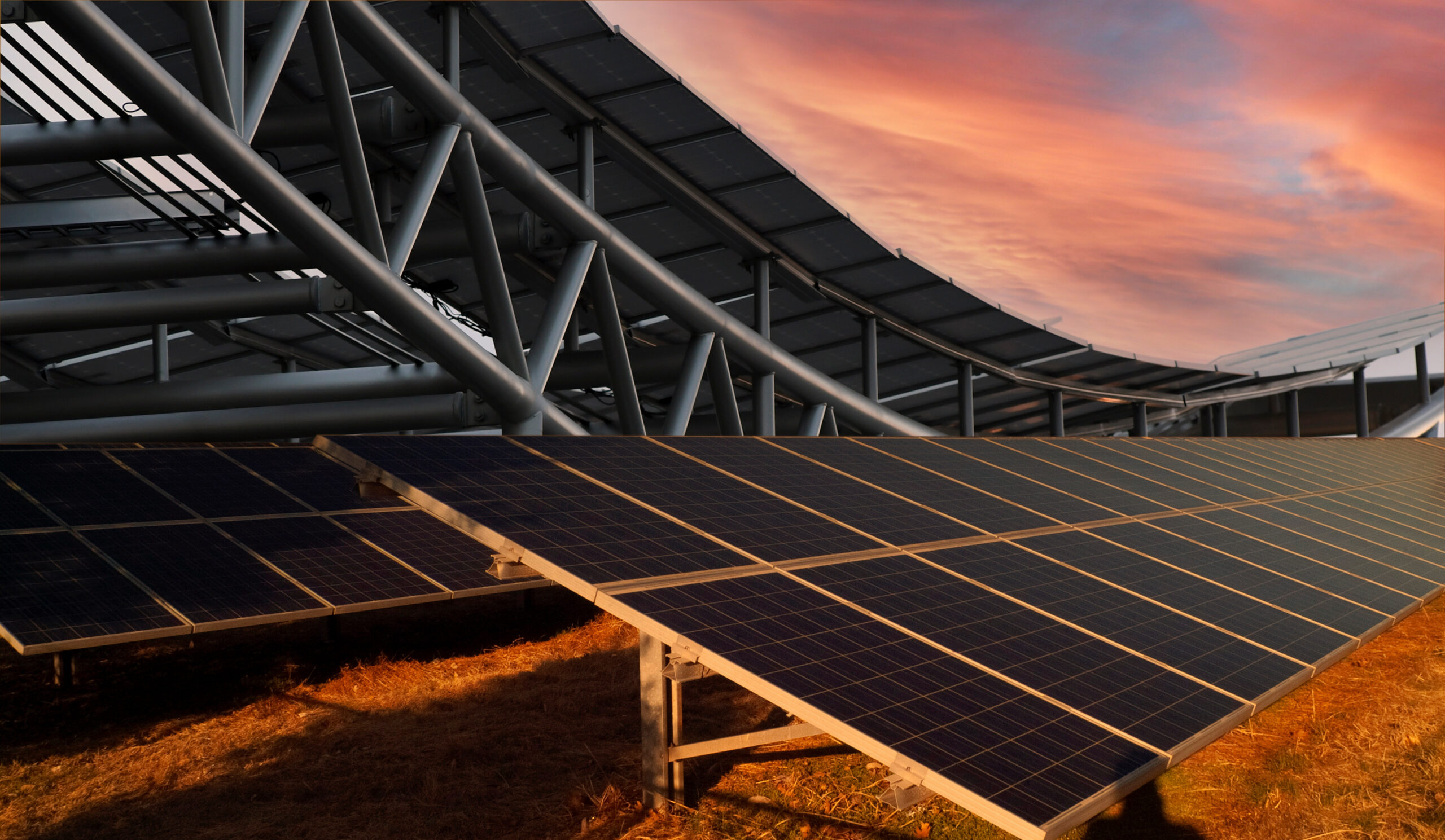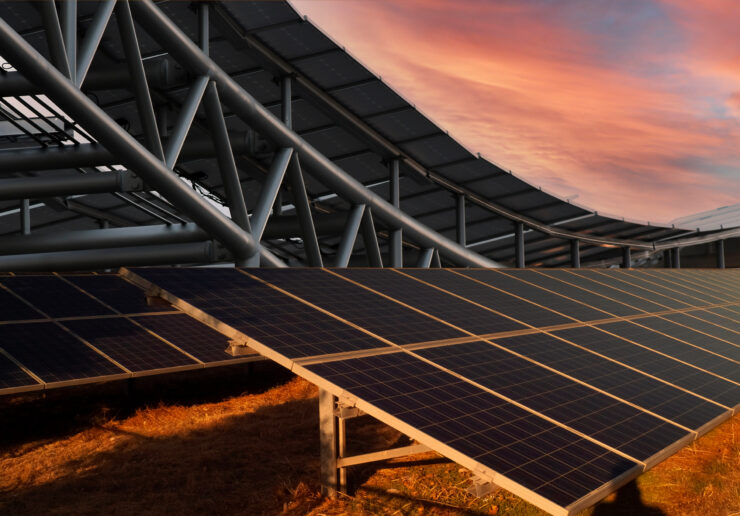
Solar energy runs on metal. Copper, silver, zinc, aluminum, and (of course) steel help harness solar rays, turning them into electric current. This synergistic relationship has created a dynamic partnership between solar suppliers and metal fabrication companies.
Solar panel and rack manufacturers use many different metals in their products, but these metals come from the same ore and are processed into sheets, tubes, rods, extruded shapes, and other forms before being used to create solar panels or racks for photovoltaic systems.
Did you know many of Kloeckner Metals’ nationwide branches boast special processing capabilities for the solar industry? Download our solar brochure now to see how Kloeckner Metals can service your solar needs.
If you’re a solar supplier, it’s important to understand which metals are formed and used by solar component manufacturers so that you can best serve your customers’ needs. Here’s a guide to the most common types of metal used in solar components:
The primary metals used in a solar panel include aluminum, steel, copper, silver, and zinc. Aluminum or steel often composes the racks and support system. Sometimes, aluminum supplies the wiring as well. Copper may make up the wiring of the solar array. Silver is an excellent conductor. And zinc oxide improves solar-cell efficiency. Many minor metals are also used in solar cell production.
For the racks, most manufacturers rely on either aluminum or steel. Many solar industry suppliers choose aluminum because it is versatile and relatively inexpensive compared to steel or copper. Aluminum is also a strong, lightweight metal, which is ideal for a long-lasting products like solar panels.
Recently, stainless steel has grown in popularity and is now poised to eclipse aluminum for solar racks. Steel’s greater strength allows it to support larger modules while its corrosion resistance qualities can exceed those of aluminum.
Aluminum provides three primary services in a solar panel array:
Lightweight, ductile, and highly corrosion resistant, aluminum makes an excellent support for solar systems. Its high strength-to-weight ratio means it can support a large and heavy solar array without weakening the roof of a residential facility.
Aluminum’s electrical conduction powers first brought the metal to the attention of power companies as early as 1900. The 1ххх, 6ххх, and 8ххх aluminum families have all proven themselves efficient and cost-effective as conductors. This makes aluminum a great choice for solar power manufacturers.
Initially, solar suppliers used silver as a conductive metal. While silver does possess excellent conduction qualities, it is also very expensive. Replacing silver with aluminum cuts the cost of production, savings that manufacturers can pass on to residential customers.
While aluminum has been the standby metal for solar panel production, stainless steel is quickly gaining in popularity. It offers the same lightweight material and corrosion resistance that aluminum provides while also providing greater strength and longevity. Consequently, stainless steel is probably a better choice for supported roofs than aluminum.
Although stainless steel features a lower thermal conductivity than many other metals, the design of most solar panels means the energy does not have to go far. Thus, its relatively low conductivity does not hinder solar-electric production. In addition, stainless steel roofing can pair nicely with amorphous photovoltaic cells, often eliminating the need for traditional silicon cells altogether.
Some solar manufacturers rely on copper, nickel, and zinc to help form their cells, mounts, arrays, or pumps. When refined, these metals produce a range of so-called rare metals, including silicon, indium, gallium, selenium, cadmium, and tellurium. Rare metals also play a part in creating solar cells. For example, silicon cells require cadmium, tellurium, and gallium to help transform raw silicon into an effective energy conductor.
Silver is no longer widely used to produce solar panels. Some manufacturers, however, may still create portions of their products using silver. The amount of silver used in a solar panel depends on the type of solar technology being used.
For example, cadmium telluride-based modules require less than 10 grams per square meter. Copper indium gallium selenide (CIGS) cells require 20-30 grams per square meter, and copper zinc tin sulfide cells require 60-80 grams per square meter.
Metals often get used at different stages in the solar panel production process. Metal stamping and extrusions are two processes that use metal materials like aluminum, copper, or steel as inputs. These processes often require large quantities of metal products and are essential in the construction of high-quality solar panels.
Metal extrusions and metal stampings are integral components of solar panel suppliers’ production. Extrusions provide strength and stability to the solar panels as well as protective ribs around connectors that make sure the glass doesn’t crack from moving or slamming into objects during transit.
Metal stamping helps create connectors, poles, and screw bosses that help hold structures together when a rack is assembled from multiple parts. It also provides a surface onto which the solar panels can be screwed down in addition to other components like grounding wires for safe electrical connection.
Silicon wafers are the building blocks of solar cells. A non-metallic type of quartz, silicon is a semiconductor that conducts electricity because it has a surplus of electrons in its outermost atomic layer. It often makes an ideal switching mechanism, but these wafers come in different types depending on their properties and intended use.
To make the wafers, manufacturers slice silicon into thin wedges. They then dope the cells, which means to add impurities that improve the silicon’s conduction capability. Two of these impurities are common metals — aluminum and copper oxide. The silicon then has the metal alloys formed on it, before being cut into wafers that are used to make solar cells.
Did you know many of Kloeckner Metals’ nationwide branches boast special processing capabilities for the solar industry? Download our solar brochure now to see how Kloeckner Metals can service your solar needs.

Steel base plates are fundamental elements employed in various manufacturing...
Metal fabrication is a critical process that transforms raw metal...
The solar industry has undergone a significant transformation by incorporating...

X
The Kloeckner Metals website uses modern technologies. Unfortunately, your browser doesn't support those technologies.
Download the latest version of one of these browsers to experience the site: